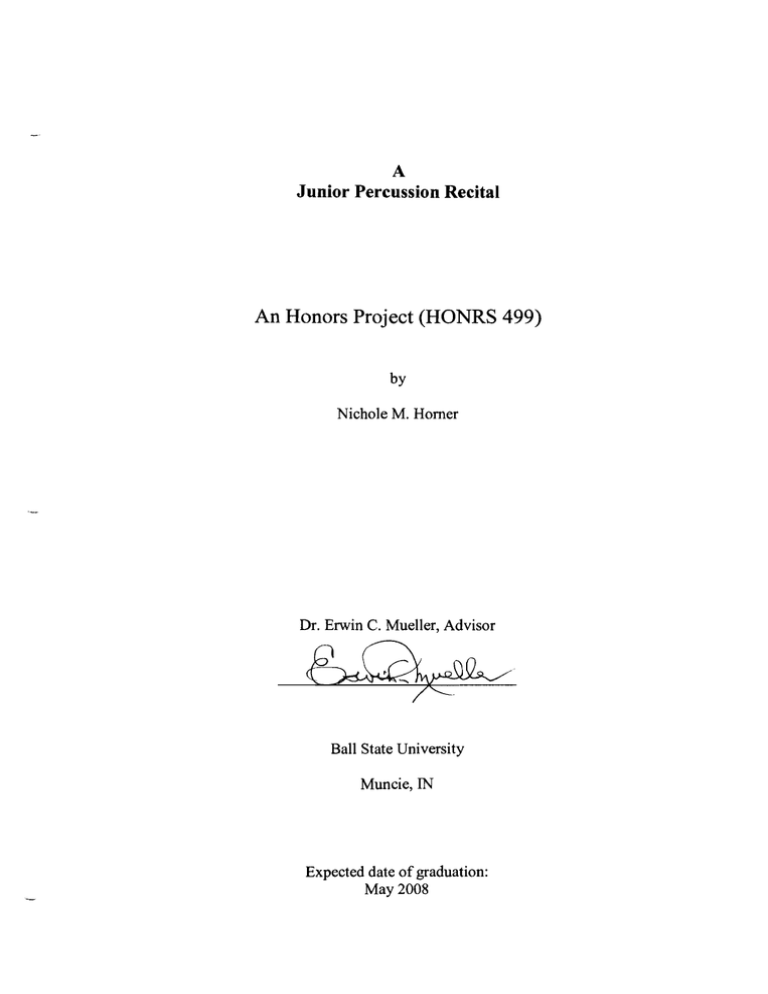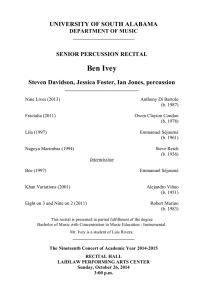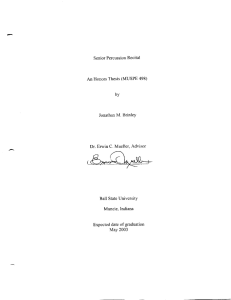An Honors Project (HONRS 499) Junior Percussion Recital A
advertisement

A Junior Percussion Recital An Honors Project (HONRS 499) by Nichole M. Horner Dr. Erwin C. Mueller, Advisor Ball State University Muncie, IN Expected date of graduation: May 2008 Abstract: Toward the end of my sophomore year at Ball State University, I began planning and preparing for the recital that would take place during the spring semester of my junior year. One of the most important aspects of any recital is variety. As musicians, we are all trained in many different genres and styles, but as percussionists, we learn to perfonn them on a greater variety of instruments than any other musicians. My percussion studies at Ball State have been no exception to this, and I felt it important to display my skills on a wide range of instruments, genres, styles, timbres, and moods. The literature on this program displays my abilities as a perfonner on the three principal instruments of percussion study: timpani, snare drum, and mallet percussion. The recital opened with March, a solo timpani piece that makes a dramatic statement, not only musically, but also visually, with significant movement between drums, flipping mallets to use the wooden ends, and dampening the heads with felt mutes. The use of the wooden ends of the mallets and the mutes on various drums provide a variety of timbres within the piece as well. The next selection consists of movements from a transcription of Johann Sebastian Bach's Suite No.1 G-Dur BWV 1007 for cello. The softer dynamic levels, prevalence ofrubato, and wistful tonality of this piece provide quite a contrast to the preceding timpani piece. The low register of a marimba lends itself well to emulating the wannth of a cello, creating the illusion of sustained notes that are only held by the natural decay of tone after the bar has been struck. Losa for Vibraphone and Marimba Duo provides another glimpse into the versatility of mallet percussion instrument, and is full of rhythmic complexity and much more articulate passages than Suite No.1. The syncopation and dynamic contrasts as well as the presence of two very different timbres in the vibraphone and marimba provide the audience with a piece of music that is not only complex to the ear but enjoyable to hear. The next piece on the program was Delecluse #9 and is recognized as advanced concert snare drum literature, widely used for undergraduate, graduate, or professional ensemble auditions. This selection demonstrates flexibility and technical accuracy on snare drum, and its complex rhythmic structure calls for a very rigid tempo and intense concentration. Prelude and Blues (Mvt. 1) for vibraphone provides the audience with a change in intensity and mood. Although the chords used are somewhat dissonant, the effect is calming as the arpeggiations blend together in washes of sound. Sensitivity in use of the pedal in this piece is crucial to create the right mood. Too much becomes too choppy, and too little makes the individual notes indiscernible. I chose this piece because I believe it demonstrates the vibraphone's ability to support a long melodic line as well as some influence from the jazz style in the chord structure and some of the rhythmic motives. Finally, I chose to end the program with Keiko Abe's Prism Rhapsody for Marimba and Orchestra. In itself, this piece consists of a larger variety of technical and musical challenges than any other piece on the recital. From the six-mallet opening to the amount of room for interpretation in the cadenza to the dizzying final theme, this piece is an exciting challenge for the perfonner as well as a captivating piece on which to end a perfonnance. Acknowledgements First, r would like to thank Dr. Mueller for his commitment to music and his students. I really appreciate the extra time and energy spent working with me, pushing me to reach not just my goals, but much farther than r ever could have thought possible. Your devotion to your students truly sets you apart from many teachers, and r am incredibly grateful to have had the opportunity to study with and learn from you. Another important person in my development as a musician has been Mrs. Mueller. Your dedication to the percussion studio is absolutely amazing. Those of us who have had the opportunity to perfonn with you have learned a great deal about listening and putting ourselves into the music, rather than only reading and interpreting what is given to us on the page. My family, John, and Michelle have been my support network through the last four years and the preparation for this recital was no exception. You have helped me celebrate the victories and been there for me when things have gone awry. r am so lucky to have such wonderful people in my life. Finally, I want to thank the percussion studio for the fun and laughs that I will always remember and cherish. You have made my time at Ball State an unforgettable experience that will always be special for me. Process and Reflection Process: I began preparing for this recital at the end of the spring semester of 2006. I was fortunate enough to borrow a 4 V2 octave marimba for the summer break so that I could begin work on Prism Rhapsody. I started this piece nearly a full year before my recital was scheduled in order to compete in the undergraduate concerto competition in January 2007, and I was one ofthe three finalists selected to solo with the Ball State Symphony Orchestra in April. Once the school year began, I took two hours of private lessons each week in addition to approximately ten to fourteen hours of practice time per week. During the last month before my recital, I began spending more time performing my pieces for my friends so that I was more accustomed to playing in front of people. I also spent more and more time with my accompanist, working out minor phrasing details and learning how my parts fit with hers. By the week preceding the recital, I was simply running pieces from start to finish, getting a feel for playing through the mistakes that happened and not letting them disrupt my concentration on the piece as a whole. Reflection: Looking back, this recital is easily one of the best performances I have given. I was comfortable with all of my music, and fully understood the nuances of each piece. In comparing my first recital with this one, a huge amount of growth as a musician and performer can be seen. Not only are the pieces I chose more difficult, but the sound I produced was much more mature and seemed to come more naturally. I was very pleased with the final product of my work during the year leading to this recital, and can honestly say that this performance was a large part of my decision to pursue a graduate degree in percussion performance. I discovered that I was capable of much more than I initially thought, and that although a strong recital requires a vast amount of hard work and dedication, it is worth it to step off the stage and know that your audience did just hear you play, but was drawn in to really listen. Nichole M. Homer Percussion In a Junior Recital Program Notes March Elliott Carter has been a successful composer for vocal and instrumental soloists, as well as small and large ensembles since the 1930s. He has earned two Pulitzer Prizes, as well as the Gold Medal for Music awarded by the National Institute of Arts and Letters, and the National Medal of Arts. This selection, March, from Eight Pieces/or Four Timpani is the eighth work in a series that was first published in 1949. Each of the eight works are dedicated to specific timpanists, this one to Saul Goodman, former principal timpanist with the New York Philhannonic Orchestra, and faculty member at Juilliard School of Music. This piece makes use of a compositional technique that was later labeled "metric modulation." When a metric modulation takes place, a note value that was present in the first time signature stays the same while the pulse around it changes. This technique allows Carter to explore the themes and motives created by his use of two marchlike rhythms that are superimposed. For the performer, the result is a challenge not only in counting rhythms and feeling time, but also in balancing the independence of each line with the overall direction ofthe piece. Suite No.1 G-Dur BWV 1007 Suite No.1 in G Major is the first ofa set of six composed for solo cello by Johann Sebastian Bach. Though known to many for his expertise in creating complex contrapuntal lines and dense harmonic textures, this solo work displays Bach's understanding of how to write specifically for the cello. The suite provides a fairly typical example of Baroque suite form, beginning with a prelude that could serve to wann up the musician and the instrument as it moves through chords in the tonic key in even sixteenth-note rhythms. The Sarabande, as would be expected, is written in triple meter, with an overall binary form. The next two movements are optional dances, for which the composer could have chosen bourees, gavottes, or, as in this case, minuets. The Minuets feature a change from major to minor, creating a contrast in mood between the two dances. Both are written in binary form, and feature clear phrase structure and cadences. The final movement is the Gigue, a lively closing movement that returns to the major mode in a quick duple-meter. In the sixteenth and seventeenth centuries, there were typically two types of Gigues, French and Italian. The French type is quite complex, featuring rhythmic variety and imitative counterpoint. This example is more Italian in nature, with a faster tempo and simpler melodic line. Losa for Vibraphone and Marimba Duo Emmanuel Sejoume, composer of Losafor Vibraphone and Marimba Duo, was born in France. He attended the National Conservatory ofStrasbourg, where he became familiar with percussion instruments and performance. Currently, he works as a teacher, composer, and performer specializing on vibraphone and marimba at the Strasbourg Conservatory in France. This piece, Losa, features interesting harmonies and syncopated rhythms that provide a challenge on an individual level for each performer, then again as a duo in attempting to put the two parts together. It is evident that neither part is "the lead," as the melody is handed back and forth between the performers, with each feeling as the soloist at some point. Douze Etudes No.9 In the world of snare drum, no name stands out more than Jacques Delecluse. His book, Douze Etudes pour Caisse-Claire is often the source of audition materials for professional and educational ensembles. At first glance, these etudes appear ridiculously complex, but the key to understanding them is often in the tempo and pulse of each specific exercise. Once the performer finds a subdivision that falls logically into her hands, the rhythms do not seem so intimidating. Much difficulty, however, lies in achieving the intended range of dynamics which often change seemingly mid-phrase, requiring a great deal of practice to accurately perform what has been written. Prelude and Blues Brazil native Ney Rosauro is one of the most prolific contemporary composers of percussion literature. He took an interest in percussion instruments during his last year of undergraduate study at the Universidade de Brasilia. Following his graduation, he moved to Germany to study percussion with Professor Siegfried Fink. His Concerto No.1 for Marimba and Orchestra was written as part of his Masters studies at the Hochschule fur Muzik Wurzburg. He completed his Doctoral degree at the University of Miami, where he is now Director of Percussion Studies. Of Prelude and Blues, Rosauro states, "I wrote this piece with the purpose of developing a piece in the jazz idiom." The first movement consists of soothing arpeggiated chords that, because of their minor quality, can be almost haunting. The steady pulse and easy feel create a relaxing contrast to much of the mainstream percussion literature that consists of loud dynamics and fast rhythmic changes. Prism Rhapsody for Marimba and Orchestra Keiko Abe, composer of Prism Rhapsody, was, in 1993 the first woman to be inducted into the Percussive Arts Society Hall of Fame. She has composed more than fifty pieces, and debuted nearly two hundred. In addition to her busy life as a composer, performer, and guest artist/lecturer, she is Professor of Marimba at Toho Gauken School of Music in Tokyo, Japan. Prism Rhapsody for Marimba and Orchestra, premiered in Sweden in 1996 by Abe and the Umea Symphony Orchestra, is one of her most well known works, and requires the performer to be fully comfortable with two-, four-, and six-mallet technique. It contains improvisatory sections that seem to twist and change on their own as the piece progresses as well as rhythmic and melodic passages that test the performer's ability to create many different moods within the same musical work. The concerto concludes with rapidly accelerating rhythmic passagework by the performer that requires great concentration and accuracy, and is very exciting for the listener as well as the performer. Bibliography Abe, K. Home page. 2007. 5 April 2008. <http://www.keiko-abe.com>. Benadon, F. "Towards a Theory of Tempo Modulation." Proceedings of the Slh International Conference on Music Perception and Cognition. Evanston, IL. (563-566). Fairchild, F. "Saul Goodman." 27 March 2008. <http://www.pas.org/AboutiHOF/goodman.cfin> . G. Schirmer, Inc. and Associated Music Publishers. "Elliott Carter." 27 March 2008. <http://www.schirmer.com!default.aspx?tabId=2418>. Herman, J. "Elliot Carter in Brief." The Elliott Carter Centenary. 27 March 2008. <http://www.carterl00.com/bio.html>. Rosauro, N. Home page. 2000. 5 April 2008. <http://www.neyrosauro.com>. Sejourne, E. Home page. 2007. 29 March 2008. <http://www.emmanue1sejourne.com!essais/site2004/index.htm> . Tarr, E. H. "Johann Sebastian Bach." The New Grove Dictionary ofMusic and Musicians, ed. Stanley Sadie. Vol. 2. London, Eng: Macmillan Publishers Limited, 2001. Winold, A. Bach's Cello Suites. Vol. 1. Bloomington, IN: Indiana University Press, 2007.

